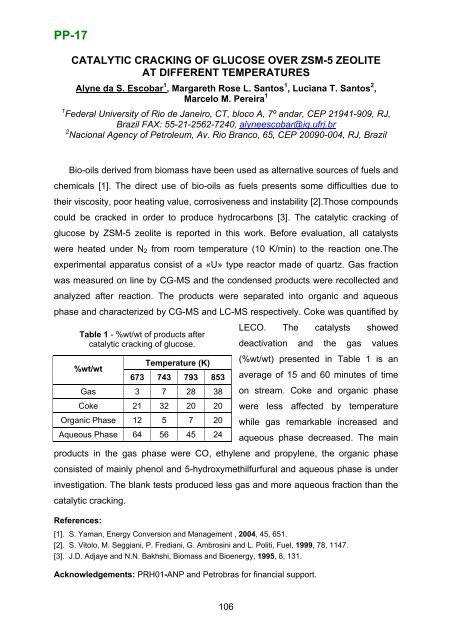Boreskov Institute of Catalysis SB RAS, Novosibirsk, Russia
Boreskov Institute of Catalysis SB RAS, Novosibirsk, Russia
Boreskov Institute of Catalysis SB RAS, Novosibirsk, Russia
- No tags were found...
You also want an ePaper? Increase the reach of your titles
YUMPU automatically turns print PDFs into web optimized ePapers that Google loves.
PP-17CATALYTIC CRACKING OF GLUCOSE OVER ZSM-5 ZEOLITEAT DIFFERENT TEMPERATURESAlyne da S. Escobar 1 , Margareth Rose L. Santos 1 , Luciana T. Santos 2 ,Marcelo M. Pereira 11 Federal University <strong>of</strong> Rio de Janeiro, CT, bloco A, 7º andar, CEP 21941-909, RJ,Brazil FAX: 55-21-2562-7240, alyneescobar@iq.ufrj.br2 Nacional Agency <strong>of</strong> Petroleum, Av. Rio Branco, 65, CEP 20090-004, RJ, BrazilBio-oils derived from biomass have been used as alternative sources <strong>of</strong> fuels andchemicals [1]. The direct use <strong>of</strong> bio-oils as fuels presents some difficulties due totheir viscosity, poor heating value, corrosiveness and instability [2].Those compoundscould be cracked in order to produce hydrocarbons [3]. The catalytic cracking <strong>of</strong>glucose by ZSM-5 zeolite is reported in this work. Before evaluation, all catalystswere heated under N 2 from room temperature (10 K/min) to the reaction one.Theexperimental apparatus consist <strong>of</strong> a «U» type reactor made <strong>of</strong> quartz. Gas fractionwas measured on line by CG-MS and the condensed products were recollected andanalyzed after reaction. The products were separated into organic and aqueousphase and characterized by CG-MS and LC-MS respectively. Coke was quantified byLECO. The catalysts showedTable 1 - %wt/wt <strong>of</strong> products aftercatalytic cracking <strong>of</strong> glucose. deactivation and the gas valuesTemperature (K)(%wt/wt) presented in Table 1 is an%wt/wt673 743 793 853 average <strong>of</strong> 15 and 60 minutes <strong>of</strong> timeGas 3 7 28 38 on stream. Coke and organic phaseCoke 21 32 20 20 were less affected by temperatureOrganic Phase 12 5 7 20 while gas remarkable increased andAqueous Phase 64 56 45 24 aqueous phase decreased. The mainproducts in the gas phase were CO, ethylene and propylene, the organic phaseconsisted <strong>of</strong> mainly phenol and 5-hydroxymethilfurfural and aqueous phase is underinvestigation. The blank tests produced less gas and more aqueous fraction than thecatalytic cracking.References:[1]. S. Yaman, Energy Conversion and Management , 2004, 45, 651.[2]. S. Vitolo, M. Seggiani, P. Frediani, G. Ambrosini and L. Politi, Fuel, 1999, 78, 1147.[3]. J.D. Adjaye and N.N. Bakhshi, Biomass and Bioenergy, 1995, 8, 131.Acknowledgements: PRH01-ANP and Petrobras for financial support.106
















